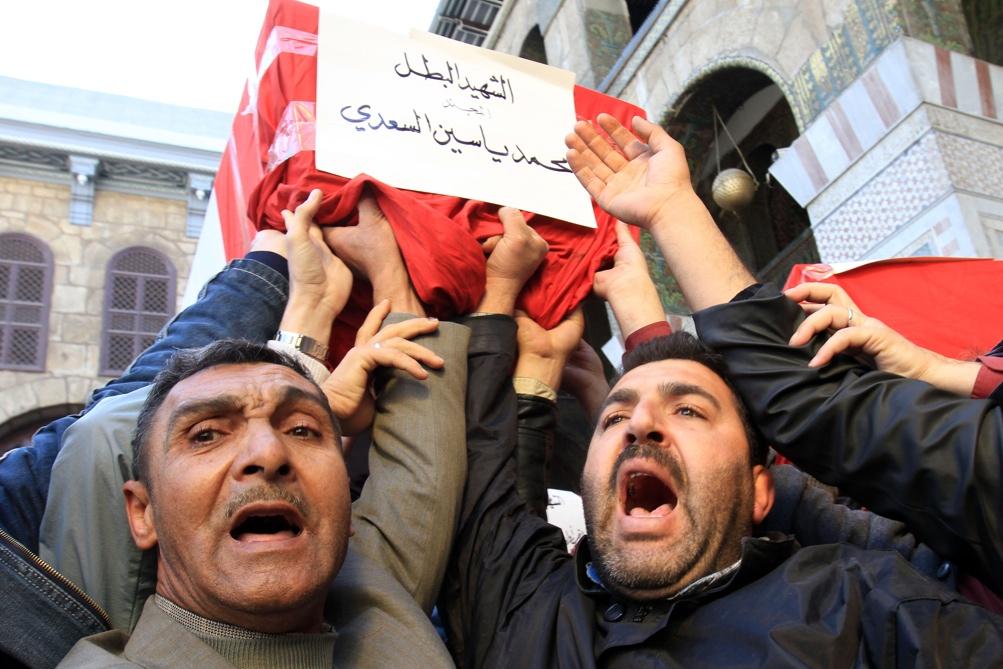Syria: Was Al Qaeda really to blame for the Damascus suicide bombings?
Syrian mourners carry a coffin during the mass funeral of 44 people killed in twin suicide bombings that targeted intelligence agency compounds in Damascus on Dec. 24, 2011.
BOSTON — I lived in Damascus from January 2010 until this July and every morning when I stepped off a green city bus in the upscale Kafar Souseh neighborhood, I passed by a row of young, gun-wielding guards monitoring traffic on the road to my office. Only a few cars — and unobtrusive pedestrians like myself — could enter this section of the road.
A quarter mile from the checkpoint, I used to walk past the ominous gates of the intelligence agency headquarters, flanked by more guards. A steel gate protected it and thick, automated metal pillars stuck up in a row along the entryway, which guards behind the gate lowered to allow approved cars to enter.
Yet the regime says that on Dec. 23, a car bomb packed with explosives somehow pulled up to the compound’s main entrance and detonated, killing dozens of people. It was one of two attacks on Syrian security facilities that day, killing 44 people altogether. This is according to the Syrian government, which immediately issued a statement blaming Al Qaeda and plastered gruesome photos of disfigured bodies across its media.
More from GlobalPost: Syria: Labor strikes take hold across country
International news outlets quickly repeated this accusation. Guardian columnist Jonathan Steele called it “a tactic of carnage not yet seen in the uprising against the government” that was “almost certainly the work of Al Qaida sympathizers.”
But the evidence to support such claims is thin at best. The only relevant recent news came earlier that week, when the Syrian government and Lebanon’s defense minister said that a border town in the Bekkah Valley had become a base for Al Qaeda.
The statement was quickly dismissed by those who argued that the regime was attempting to justify plans for a cross-border attack on a Syrian refugee community in the area.
Were the bombings similarly concocted by the Syrian regime to support its claim that the widespread protests that have gripped the country for months are the act of foreign “terrorists?”
The only thing certain in Syria right now is the willingness of the regime to use any means necessary to stay in power. The tactics of those who oppose it remain mostly peaceful, with the primary exception of the Free Syrian Army, which denied responsibility for this attack (while proudly claiming responsibility for assaults on other government entities).
More from GlobalPost: Introducing the Free Syrian Army
Yet most stories about the incident repeated the government position. After months of almost kneejerk condemnation of the regime’s brutal tactics, the international community mostly trusted the government to provide honest information about a violent incident inside its closed-off borders.
Ausama Monajed, spokesman for the Syrian National Council, told me: “It is laughable how some willingly fall into the exact trap the regime sets up.”
In fact, Al Qaeda — which claimed responsibility for a similar attack in Baghdad — denies it backed this bombing and has no record of previous attacks inside Syria. Briefly after the bombings, a web site mirroring the Syrian Muslim Brotherhood’s claimed responsibility for the attacks. The website was quickly deemed fraudulent and it disappeared from the internet. The Syrian Muslim Brotherhood has issued a statement disavowing the site.
While a few outlets noted that opposition groups blame the regime instead of Al Qaeda for the attack, the argument gained little traction.
Well-known Syria commentator Joshua Landis wrote on his Syria Comment blog that, when presented with the argument that it was the regime itself that staged the attacks, “It reminds me of the notion that Washington was behind the World Trade Center bombing to provide a pretext for invading Iraq. I don’t give either much credibility. Both fit a rather perverse ‘qui bono,’ or ‘who benefits’ text, but I shouldn’t think that either are likely.”
It is true that the incident benefited the Syrian regime. It frightened the international community, terrified Syrians and, on the first day of a visit of Arab League monitors tasked with identifying the source of the bloodshed, bolstered the regime’s claims that terrorists are to blame for the violence. It also provided a distraction from ongoing crackdowns throughout the country, particularly a push to quell dissent in Homs before the delegation could monitor the situation there.
Landis rightly points out that identifying who benefits does not necessarily reveal who is responsible. But the comparison to the Sept. 11 conspiracy theory doesn’t work. The Syrian regime has proved that it would do anything to retain power, killing thousands of its own unarmed citizens over the course of nine months.
The opposition says the regime went so far as to pile bodies of deceased prisoners that were held at the facility to stage the scene of carnage. Just minutes after the explosions, in fact, photos of the bodies went online and the government issued a statement pinpointing the supposed culprit. In its analysis of the attack, the opposition also points out the perimeter of checkpoints that encircle the intelligence headquarters.
Having walked the desolate road past the compound countless times, I too find it implausible that Al Qaeda could simply pull up to the front door of Syria’s notoriously efficient secret police network and provide the regime with the perfect distraction.
As in most things in Syria, it is difficult to know the absolute truth. Proving with absolute certainty who attacked the buildings is impossible. Interpreting their source, however, is rather obvious.
Our coverage reaches millions each week, but only a small fraction of listeners contribute to sustain our program. We still need 224 more people to donate $100 or $10/monthly to unlock our $67,000 match. Will you help us get there today?
